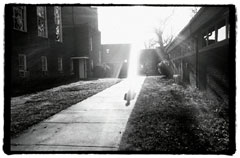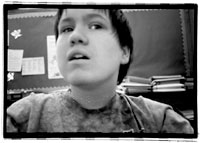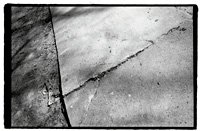Lighting the Way: Pictures Help People See from Another Point of View
Photography is a revelation, and a learning tool, for visually impaired students.
Your content has been saved!
Go to My Saved Content.
What would children who are blind show us about the world if they learned to take pictures? The question first occurred to photographer Tony Deifell in 1991, soon after graduating from the University of North Carolina at Chapel Hill, where he studied anthropology. A year later, he sought an answer by setting up an experimental photography program, called Sound Shadows, at Governor Morehead School for the Blind, in Raleigh, North Carolina.
The state-funded Governor Morehead is North Carolina's only school for the visually impaired; established in 1845, it is one of the oldest in the United States. Sound Shadows was based there for five years, from 1992 to 1997, during which Deifell cotaught thirty-six students ages 12-19 with visual impairments. The kids not only learned how to point and shoot, they also were taught how to use a camera to re-create dreams and express personal vision.
In April 2007, Chronicle Books published Seeing Beyond Sight, Deifell's richly illustrated record of his experience at the school. The book features about 150 images from the Sound Shadows program, accompanied by the words of their creators as well as updates on many of the student photographers.

In the book's introduction, Deifell concedes that in 1992, taking Sound Shadows from concept to curriculum was no easy task. He had the examples of many visually impaired artists to inspire him, but it was still unheard of to actually teach photography, the least tactile of the arts, to blind students. The proposal was so unusual that when Deifell approached the school, the outreach director thought it was a joke.
But not long after Sound Shadows got under way, Sheila Breitweiser, the school's superintendent at the time, received a package from a student in the program that demonstrated the project's benefits. With her first roll of film, Leuwynda Forbes, then eighteen, had aimed her mechanical eye at cracks in the school's sidewalks. Deifell was dismayed at first, thinking that precious film had been wasted on accidental exposures. Then he saw the note Forbes had attached to one of the photographs, a message for Breitweiser that read, "Since you are sighted, you may not notice these cracks. They are a big problem, since my white cane gets stuck in them." The cracks were promptly fixed.

"What surprised me was the confidence and assertiveness of one of our kids, and the wherewithal to provide evidence," the superintendent recalls. Also important to Breitweiser was that Forbes's work, like all of the students' photos, was an opportunity for discussion, essential in Sound Shadows to help the students "see" their photographs after they had taken them.
With autofocus cameras, the students used sound as an informant, and touch as a way to compose their images. But to envision the photographs -- to assess them and learn from them -- required the teachers and students to discuss the prints. The teachers would faithfully report what they saw in each picture, and the students merged those descriptions with what they had perceived or imagined while in the field.
One student, John Vieregge, then nineteen, took what he believed was a photograph of a shrimp boat (he had heard it), but the vessel was so far in the distance that his teachers thought it was a serendipitous image of seagulls caught in flight. The teacher praised the image, as recounted in Seeing Beyond Sight, saying, "Oh, I love this picture of these birds."
"What do you see in the background?" Vieregge responded. When the teacher mentioned only the surf, Vieregge pointed out, "I believe there was a shrimp boat out there."
Recalling the exchange, Deifell wrote, "If it weren't for the teachers, John would not have 'seen' the seagulls, and if it weren't for John pointing out the shrimp boat, we, as teachers, would not have 'seen' the shrimp boat."
Critiquing of photographs was of course collaborative, but finding a shot and setting it up was often an independent project. "A lot of the students had been insulated -- in classrooms, in dorms," explains Dan Partridge, a Governor Morehead teacher during Sound Shadows and now a research associate for Duke University's Jazz Loft Project. "They weren't really called on to interact with the outside world or the visual world, and that's such an important part of communication. Photography was a vehicle for the students. We weren't looking for the best photographs; we were allowing them to do everything on their own. The goal was to feel like they could communicate with anybody on any level."
For Merlett Lowery, a student frightened by the noises the school's maintenance crew made when they worked, this goal meant confronting the source of her unease. Lowery, thirteen at the time, made a phone call, set up an appointment to meet the groundskeepers, and made a plan to record them on film. She executed the assignment so well that she decided to make her own book of the images. In capturing the leaf blowers and lawn mowers on the page, Lowery quieted her fears.
With autofocus cameras, the students used sounds as an informant, and touch as a way to compose their images.
Credit: Chronicle Books"It was great when they were able to understand their life and express it," Partridge says. "People can walk into photography and take a great picture, but it takes a long time to learn how to interact with one's world and form existential questions."
Parker J. Palmer, teacher, activist, and author of The Courage to Teach, concurs: "Education bears a terrific responsibility for cultivating wide seeing or narrow seeing. It's not an unfair generalization that our colleges and universities turn out way too many people who have power in the world, but no insight or vision, no cultivated way of seeing its possibilities, or what it is that's driving them."
Sound Shadows prepared the students at Governor Morehead for just this kind of inquiry by helping them explore their own identities. One photograph in Deifell's Seeing Beyond Sight shows Merlett, who is black, holding hands with her best friend Reba, who is white. Merlett had previously claimed to dislike white people, so, in discussing the photograph, Deifell broached the subject. "Tell me about Reba," he said. "Reba is white, isn't she?" Merlett said she didn't know. All she knew was that Reba had long hair. "She doesn't act white?" ventured Deifell. "How does she act?" "Like us," answered Merlett.
"All media create reality," says Elana Yonah Rosen, cofounder and executive director of the nonprofit organization Just Think, which teaches media literacy through habits of inquiry and skills of expression. The San Francisco-based group's curricula and innovative programs strive to keep students on their toes in a culture highly impacted by media.
"What you get with Sound Shadows is the vantage point of someone who you think cannot see," says Rosen. "But we find the exact same identity issues as a sighted person."
The camera served the school's students inside the classroom too. "You don't need vision to have a learning disability," says Governor Morehead teacher Shirley Hand. "Dyslexia in Braille is the same as dyslexia in print." Linking photography with creative writing assignments about dreams, fears, and vocations was a way for Hand and others to increase literacy and draw students closer to the dreaded Braille writer, which is complicated to learn.
What can children who are blind show us about the world once they learn to take pictures? Above all, Rosen says, "The photos insist on leaving behind preconceived ideas about people without sight, and seeing how enlightened they are, and how they shed light on our world."
Visionary Education
Investigate the following resources for blind and visually impaired students:
Learning Through Listening, the Web site of the company Recording for the Blind & Dyslexic, provides free educator-developed lesson plans, activities, teaching strategies, and other resources.
The National Center for Blind Youth in Science, an initiative of the National Federation of the Blind's Jernigan Institute, promotes full access for blind and visually impaired children to hands-on experience in science, technology, engineering, and math (STEM).